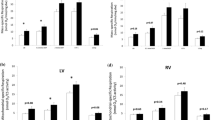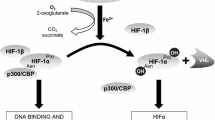Abstract
Erythropoietin (Epo)-induced polycythemia is the main factor of adaptation to hypoxia. In this study, we analysed the effects of Epo deficiency on intrinsic functional properties of slow and fast twitch muscles in a model of erythropoietin deficient mice (Epo-TAgh) exposed to hypoxia. We hypothesised that Epo deficiency would be deleterious for skeletal muscle structure and phenotype, which could change its functional properties and alters the adaptive response to ambient hypoxia. Wild-type (WT) and Epo-TAgh mice were left in hypobaric chamber at 420 mm Hg pressure for 14 days. Soleus (SOL) and extensor digitorum longus (EDL) were analysed in vitro by mechanical measurements, immunohistological and biochemical analyses. The results were compared to those obtained in corresponding muscles of age-matched normoxic groups. Our data did not show any difference between the groups whatever the Epo deficiency and/or hypoxic conditions for twitch force, tetanic force, fatigue, typology and myosin heavy chain composition. Normoxic Epo-TAgh mice exhibit improved capillary-to-fibre ratio compared to WT mice in both SOL and EDL whereas no angiogenic effects of hypoxia or combined Epo-deficency/hypoxia were observed. These results suggest that skeletal muscles possess a great capacity of adaptation to Epo deficiency. Then Epo deficiency is not a sufficient factor to modify intrinsic functional properties of skeletal muscles.




Similar content being viewed by others
References
Abbrecht PH, Littell JK (1972) Erythrocyte life span in mice acclimatized to different degrees of hypoxia. J Appl Physiol 32:443–445
Ameln H, Gustafsson T, Sundberg CJ, Okamoto K, Jansson E, Poellinger L, Makino Y (2005) Physiological activation of hypoxia inducible factor-1 in human skeletal muscle. FASEB J 19:1009–1011
Bigard AX, Brunet A, Guezennec CY, Monod H (1991) Effects of chronic hypoxia and endurance training on muscle capillarity in rats. Pflugers Arch 419:225–229
Bigard AX, Brunet A, Guezennec CY, Monod H (1991) Skeletal muscle changes after endurance training at high altitude. J Appl Physiol 71:2114–2121
Binley K, Askham Z, Iqball S, Spearman H, Martin L, de Alwis M, Thrasher AJ, Ali RR, Maxwell PH, Kingsman S, Naylor S (2002) Long-term reversal of chronic anemia using a hypoxia-regulated erythropoietin gene therapy. Blood 100:2406–2413
Blum H, Beier H, Gross HJ (1987) Improved silver staining of plant proteins, RNA and DNA in polyacrlyamide gels. Electrophoresis 8:93–99
Bozzini CE, Barcelo AC, Conti MI, Martinez MP, Alippi RM (2005) Enhanced erythropoietin production during hypobaric hypoxia in mice under treatments to keep the erythrocyte mass from rising: implications for the adaptive role of polycythemia. High Alt Med Biol 6:238–246
Burke RE, Levine DN, Tsairis P, Zajac FE 3rd (1973) Physiological types and histochemical profiles in motor units of the cat gastrocnemius. J Physiol 234:723–748
Cayla JL, Maire P, Duvallet A, Wahrmann JP (2008) Erythropoietin induces a shift of muscle phenotype from fast glycolytic to slow oxidative. Int J Sports Med 29:460–465
Chaves PH, Ashar B, Guralnik JM, Fried LP (2002) Looking at the relationship between hemoglobin concentration and prevalent mobility difficulty in older women. Should the criteria currently used to define anemia in older people be reevaluated? J Am Geriatr Soc 50:1257–1264
Close RI (1972) Dynamic properties of mammalian skeletal muscles. Physiol Rev 52:129–197
Desplanches D, Hoppeler H, Linossier MT, Denis C, Claassen H, Dormois D, Lacour JR, Geyssant A (1993) Effects of training in normoxia and normobaric hypoxia on human muscle ultrastructure. Pflugers Arch 425:263–267
Deveci D, Marshall JM, Egginton S (2001) Relationship between capillary angiogenesis, fiber type, and fiber size in chronic systemic hypoxia. Am J Physiol Heart Circ Physiol 281:H241–H252
El Hasnaoui-Saadani R, Pichon A, Marchant D, Olivier P, Launay T, Quidu P, Beaudry M, Duvallet A, Richalet JP, Favret F (2009) Cerebral adaptations to chronic anemia in a model of erythropoietin-deficient mice exposed to hypoxia. Am J Physiol Regul Integr Comp Physiol 296:R801–R811
Fahal IH, Bell GM, Bone JM, Edwards RH (1997) Physiological abnormalities of skeletal muscle in dialysis patients. Nephrol Dial Transplant 12:119–127
Faucher M, Guillot C, Marqueste T, Kipson N, Mayet-Sornay MH, Desplanches D, Jammes Y, Badier M (2005) Matched adaptations of electrophysiological, physiological, and histological properties of skeletal muscles in response to chronic hypoxia. Pflugers Arch 450:45–52
Hill AV (1951) The effects of series compliance on the tension developed in muscle twitch. Proc R Soc Lond B Biol Sci 9(138):325
Hojman P, Brolin C, Gissel H, Brandt C, Zerahn B, Pedersen BK, Gehl J (2009) Erythropoietin over-expression protects against diet-induced obesity in mice through increased fat oxidation in muscles. PLoS One 4:e5894
Hudlicka O, Brown M, Egginton S (1992) Angiogenesis in skeletal and cardiac muscle. Physiol Rev 72:369–417
Ishihara A, Itoh K, Itoh M, Hirofuji C (2000) Effect of hypobaric hypoxia on rat soleus muscle fibers and their innervating motoneurons: a review. Jpn J Physiol 50:561–568
Ishihara A, Itoh K, Oishi Y, Itoh M, Hirofuji C, Hayashi H (1995) Effects of hypobaric hypoxia on histochemical fibre-type composition and myosin heavy chain isoform component in the rat soleus muscle. Pflugers Arch 429:601–606
Itoh K, Moritani T, Ishida K, Hirofuji C, Taguchi S, Itoh M (1990) Hypoxia-induced fibre type transformation in rat hindlimb muscles. Histochemical and electro-mechanical changes. Eur J Appl Physiol Occup Physiol 60:331–336
Jaquet K, Krause K, Tawakol-Khodai M, Geidel S, Kuck KH (2002) Erythropoietin and VEGF exhibit equal angiogenic potential. Microvasc Res 64:326–333
Jelkmann W (2007) Erythropoietin after a century of research: younger than ever. Eur J Haematol 78:183–205
Kanatous SB, Mammen PP, Rosenberg PB, Martin CM, White MD, Dimaio JM, Huang G, Muallem S, Garry DJ (2009) Hypoxia reprograms calcium signaling and regulates myoglobin expression. Am J Physiol Cell Physiol 296:C393–C402
Kertesz N, Wu J, Chen TH, Sucov HM, Wu H (2004) The role of erythropoietin in regulating angiogenesis. Dev Biol 276:101–110
Kopple JD, Storer T, Casburi R (2005) Impaired exercise capacity and exercise training in maintenance hemodialysis patients. J Ren Nutr 15:44–48
Kouidi E, Albani M, Natsis K, Megalopoulos A, Gigis P, Guiba-Tziampiri O, Tourkantonis A, Deligiannis A (1998) The effects of exercise training on muscle atrophy in haemodialysis patients. Nephrol Dial Transplant 13:685–699
Krogh A (1919) The number and distribution of capillaries in muscles with calculations of the oxygen pressure head necessary for supplying the tissue. J Physiol 52:409–415
Launay T, Noirez P, Butler-Browne G, Agbulut O (2006) Expression of slow myosin heavy chain during muscle regeneration is not always dependent on muscle innervation and calcineurin phosphatase activity. Am J Physiol Regul Integr Comp Physiol 290:R1508–R1514
Lensel-Corbeil G, Goubel F (1989) Series elasticity in frog sartorius muscle during release and stretch. Arch Int Physiol Biochim 97:499–509
Luedeke JD, McCall RD, Dillaman RM, Kinsey ST (2004) Properties of slow- and fast- twitch skeletal muscle from mice with an inherited capacity for hypoxic exercise. Comp Biochem Physiol A Mol Integr Physiol 138:373–382
Lundby C, Hellsten Y, Jensen MB, Munch AS, Pilegaard H (2008) Erythropoietin receptor in human skeletal muscle and the effects of acute and long-term injections with recombinant human erythropoietin on the skeletal muscle. J Appl Physiol 104:1154–1160
Maxwell PH, Osmond MK, Pugh CW, Heryet A, Nicholls LG, Tan CC, Doe BG, Ferguson DJ, Johnson MH, Ratcliffe PJ (1993) Identification of the renal erythropoietin-producing cells using transgenic mice. Kidney Int 44:1149–1162
Ogilvie M, Yu X, Nicolas-Metral V, Pulido SM, Liu C, Ruegg UT, Noguchi CT (2000) Erythropoietin stimulates proliferation and interferes with differentiation of myoblasts. J Biol Chem 275:39754–39761
Penninx BW, Pahor M, Cesari M, Corsi AM, Woodman RC, Bandinelli S, Guralnik JM, Ferrucci L (2004) Anemia is associated with disability and decreased physical performance and muscle strength in the elderly. J Am Geriatr Soc 52:719–724
Pette D, Tyler KR (1983) Response of succinate dehydrogenase activity in fibres of rabbit tibialis anterior muscle to chronic nerve stimulation. J Physiol 338:1–9
Richalet JP, Souberbielle JC, Antezana AM, Dechaux M, Le Trong JL, Bienvenu A, Daniel F, Blanchot C, Zittoun J (1994) Control of erythropoiesis in humans during prolonged exposure to the altitude of 6, 542 m. Am J Physiol 266:R756–R764
Rotter R, Menshykova M, Winkler T, Matziolis G, Stratos I, Schoen M, Bittorf T, Mittlmeier T, Vollmar B (2008) Erythropoietin improves functional and histological recovery of traumatized skeletal muscle tissue. J Orthop Res 26:1618–1626
Scoppetta C, Grassi F (2004) Erythropoietin: a new tool for muscle disorders? Med Hypotheses 63:73–75
Stevens ED, Renaud JM (1985) Use of dP/dt and rise time to estimate speed of shortening in muscle. Am J Physiol 249:R510–R513
Suzuki N, Ohneda O, Takahashi S, Higuchi M, Mukai HY, Nakahata T, Imagawa S, Yamamoto M (2002) Erythroid-specific expression of the erythropoietin receptor rescued its null mutant mice from lethality. Blood 100:2279–2288
Acknowledgements
We gratefully acknowledge Stephane Chambris for his technical support.
Author information
Authors and Affiliations
Corresponding author
Rights and permissions
About this article
Cite this article
Hagström, L., Canon, F., Agbulut, O. et al. Skeletal muscle intrinsic functional properties are preserved in a model of erythropoietin deficient mice exposed to hypoxia. Pflugers Arch - Eur J Physiol 459, 713–723 (2010). https://doi.org/10.1007/s00424-009-0775-7
Received:
Revised:
Accepted:
Published:
Issue Date:
DOI: https://doi.org/10.1007/s00424-009-0775-7




